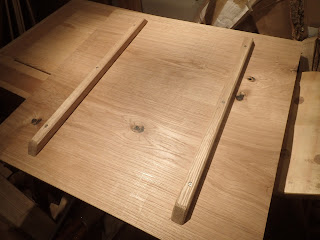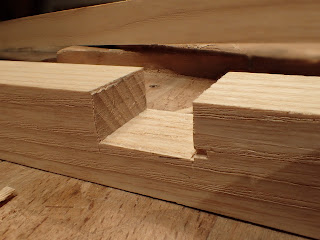Yesterday was
Part I of this review of non-Stanley #2 shaped planes. I introduced the planes I have, and compared the totes. If you don't want to read that long post, essentially I have two Fulton 3708s, one made by Sargent and the other Millers Falls, I have a Sargent VBM 407, and a Sargent 409 as a control and something known that I can compare the little ones to.
 |
| L to R - Fulton 3708 BB, 3708 BL, Sargent VBM 407, and Sargent 409 |
Today what I would like to examine is the main plane castings and frog mechanisms
I would like to first examine the above photo, a head on look at all four planes together. Please ignore the sawdust on #4 size 409 on the right - I use this plane. I rehabbed it a while back with the intention of practicing fixing an old plane up before I did it to a more valuable Stanley type 11. This plane works so well, I have yet to get to that type 11, it sits sadly in a corner of my shop while this Sargent gets the snot used out of it. I probably should have cleaned it up a bit for this photo shoot, but I didn't have much time on my lunch hour that day. :o)
Anyway, what you can see with the castings in this photo pretty much sums up my entire impressions of these planes. Starting from the right, the 409 has a nice, heavy casting which is even, but a bit on the rough side. I can attest that in use this plane isn't lacking anything other than aesthetics.
 |
| The 409. The casting has a grey tinge partly because I de-rusted it in citric acid. |
Second from the right is the Sargent VBM 407. The casting on this one looks to my eye substantial, yet a bit more refined. Holding this plane you can feel it is smoother on the edges and obvious a little more care was taken on the fit and finish of this plane during construction. I think I could get the edges of the 409 to look like this relatively easy with successively finer grits of sandpaper, but that is purely cosmetic. Still, it is nice to hold and I'm glad that someone at some point in it's manufacture took the time to do it. There is some evidence that this plane was cleaned up before I got it, but happily the dark patina of time is still all over the casting. I don't think it was sanded down after leaving the factory.
 |
| The VBM 407. At some point, someone "polished" up the lever cap grinding down the letters a bit. I imagine new the printing here was a bit crisper looking. |
Next up is the third-from-the-right Sargent made Fulton 3708 BL. Actually, I have no idea if this plane really is a model 3708, as that number is nowhere on the casting. No numbers at all. There is a "BL" on the blade, but that is it. BL is Sears' code for being manufactured by Sargent. Since it is so close in appearance to the 3708 BB, we'll go with that as a designator.
You can see in the first picture, that compared to the others this plane has the thinnest casting. It is also a bit uneven - some parts of the casting are visibly thicker than others. My impression is that this is cosmetic, and only shows that this plane went through the assembly line a little faster than the rest of the planes in this test. We will see, but so far I haven't found anything on this casting that will prevent the plane from functioning well. It's just a bit ugly.
 |
| 3708 BL - in this photo the uneven tapering of the thickness of the casting can be seen. |
Last but not least, the Millers Falls manufactured Fulton 3708 BB. The differences are subtle, but to my eye this casting is the best looking of the lot. Not too thick and clunky looking, yet also substantial enough to not be considered too thin. The thickness looks even all around, and the sharp edges are all polished and pleasingly rounded from the factory. The standard at the MF plant was obviously a little higher than they were a the Sargent plant when the other one was made.
 |
| Proportions on the 3708 BB look perfect to my eye. |
Let's take a peek now at the frogs, and how they are mated to the castings:
 |
| The dust isn't original to this plane. |
Here's where the frog beds to the casting on the 409. Sargent used these three bits of metal in the casting that they ground flat(ish) for the frog to rest on. One could file these flat, but to get them all in line and perfect would take a bit of care, I decided to see how the plane worked without doing that, and I notice no deficiencies in perfromance.
 |
| A close up of the bed. |
The frog itself has three ground places where it meets the raised bits in the bed. Sargent stamped the model number of the plane on the underside of the frog.
 |
| Underside of frog. |
The adjuster uses a regular threaded bolt. This means that to advance the blade, you have to turn the adjuster knob to the left, which is backwards of what most of us are used to. This plane is old enough to where the knob itself is what we would consider small.
 |
| Also, in this photo the yoke is one solid piece. |
The great part of this frog is the surface of the frog is ground flat, and has a lot of bearing surface for the blade. I really like frogs like this.
 |
| A nice, old-style frog. |
Let's now look at the VBM 407:
 |
| Is this a different picture? |
Looking at the close-ups of this plane, you would be forgiven for thinking you might be looking at the 409 again, just without all the dust. Nearly all the same features as it's bigger brother.
 |
| One piece yoke, small knob with "backwards" threads. |
This one also needs to be turned to the left to advance the blade. It's something you can get used to, but it is weird at first.
 |
| 407 once again stamped on the underside of the frog. Strangely, it is upside down as compared to how the 409 is stamped. I wonder why? |
A good, robust, functional design. Having used this plane, I can say it takes shavings and performs well.
 |
| Ribbit. |
Now, how about the Sargent made Fulton? What do you think this will look like?
 |
| Same picture again? |
I've reversed the order of how we'll look at this one to make it easier for you to scroll between the two to see the differences.
The guts of this plane look awfully close to the same as the VBM 407. The frog looks very, VERY similar. It wouldn't surprise me if the frog was cast in the exact same form.
 |
| This one just looks newer. |
It looks the same to me, just perhaps done a bit faster. The only significant difference in the frog is the knob is big on this one, and made of stainless steel. Also, the threads are left-handed resulting in advancing the blade achieved by turning the knob to the right. In addition, the yoke is two separate pieces. No idea what the advantage of that is. It probably was easier to manufacture.
 |
| Two piece yoke and stainless knob. |
The big difference in the bed casting is the center isn't raised, and the paint is left on. I suspect leaving the center of the frog unsupported makes it easier for the frog to feel firmly seated, as there are only two bearing surfaces rather than three to align. We'll have to see how this performs. There could be room for super-tuning here.
 |
| Paint. |
By the way, this plane hasn't always looked so shiny and new:
 |
| Here is the 3708 BL before rehab. |
Finally, the Fulton 3708 BB made by Millers Falls:
 |
| I've only noticed this on Millers Falls planes. |
Like most Millers Falls planes, the maker and number of the plane is engraved on the side. I like this about Millers falls planes, it leaves no questions.
The frog on this plane once again has a lot of bearing surface to support the blade, but the design is obviously different.
 |
| What is going on down by the mouth? |
The design of this frog mechanism is far superior, in my mind. We'll have to see how it works in practice, but the clever mechanism ensures square alignment of the frog is maintained, and moves the load of the bearing surface down close to the mouth, where it can ensure stability of the cutting surface.
It's a good theory in my mind, we'll have to wait to see if it works as I think it will.
 |
| By the way, if you haven't noticed, I got a new pair of Crocs in the mail and am using the wrapper to protect my dining table. |
The frog's casting looks like a little more care was taken in it's manufacturing. Like the BL, this one has a two piece yoke and a stainless large knob that turns right to advance the blade.
 |
| "2." Not sure what that means. Maybe because the Stanley equivalent is a #2? I doubt it. |
There was one more detail in this casting which made me smile. Look at the part that supports the front knob:
 |
| Solid front knob. |
When I tried to take off the front knob, I first twisted on the knob itself as sometimes this will loosen a front knob so a screwdriver isn't needed. This knob was rock-solid and wouldn't budge. Once I got it off, I realized that these little teeth in the casting were holding the knob in place. This is an awesome feature in my mind. I hate when I am planing and the front knob moves by unscrewing. This feature eliminates that problem.
I don't know about you, but what I am seeing is making me think the Millers Falls designed Fulton 3708 BB might be the best of the bunch. I am seeing enough little details that are in there not to be noticed, but with a function that this plane is setting itself up to be a great little user.
In my mind, the Sargent 409 works so well that it will be tough to beat in performance, so we will have to see during the test coming up in Part IV.
Before that, though, we need to look at blades, chipbreakers and levercaps in the upcoming Part III of this series.
Stay tuned...

































































